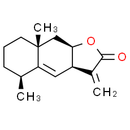Description
Alantolactone selectively suppresses STAT3 activation and exhibits potent anticancer activity in MDA-MB-231 cells.
Product information
CAS Number: 546-43-0
Molecular Weight: 232.32
Formula: C15H20O2
Synonym:
AI331147
Chemical Name: (3AR-(3aalpha,5beta,8abeta,9aalpha))-3a,5,6,7,8,8a,9,9a-octahydro-5,8a-dimethyl-3-methylenenaphtho(2,3-b)furan-2(3H)-one
Smiles: C[C@H]1CCC[C@]2(C)C[C@H]3OC(=O)C(=C)[C@H]3C=C21
InChiKey: PXOYOCNNSUAQNS-AGNJHWRGSA-N
InChi: InChI=1S/C15H20O2/c1-9-5-4-6-15(3)8-13-11(7-12(9)15)10(2)14(16)17-13/h7,9,11,13H,2,4-6,8H2,1,3H3/t9-,11+,13+,15+/m0/s1
Technical Data
Appearance: Solid Power.
Purity: ≥98% (or refer to the Certificate of Analysis)
Solubility: Soluble in DMSO
Shipping Condition: Shipped under ambient temperature as non-hazardous chemical or refer to Certificate of Analysis
Storage Condition: Dry, dark and -20 oC for 1 year or refer to the Certificate of Analysis.
Shelf Life: ≥12 months if stored properly.
Stock Solution Storage: 0 - 4 oC for 1 month or refer to the Certificate of Analysis.
Drug Formulation: To be determined.
HS Tariff Code: 382200
How to use
In Vitro:
Alantolactone induces apoptosis in HepG2 cells in a dose-dependent manner. This Alantolactone-induced apoptosis is found to be associated with GSH depletion, inhibition of STAT3 activation, ROS generation, mitochondrial transmembrane potential dissipation, and increased Bax/Bcl-2 ratio and caspase-3 activation. Alantolactone decreases STAT3 translocation to the nucleus, its DNA-binding, and STAT3 target gene expression. Alantolactone significantly inhibits STAT3 activation with a marginal effect on MAPKs and on NF-κB transcription; however, this effect is not mediated by inhibiting STAT3 upstream kinases. Alantolactone induces activin/SMAD3 signaling in human colon adenocarcinoma HCT-8 cells. Alantolactone performs its antitumor effect by interrupting the interaction between Cripto-1 and the activin receptor type IIA in the activin signaling pathway. Alantolactone (5 μg/mL, 24 h) inhibits cell proliferation in colon adenocarcinoma HCT-8 cells.
In Vivo:
It is found that the average tumor volume in the Alantolactone-treated mice is approximately 2.17-fold lower compared with that in the control mice. However the administration of Alantolactone does not affect the overall bodyweight during the experimental period, suggesting no apparent toxicity. Additionally, the average tumor weight is significantly lower in the Alantolactone-treated mice compared with the control mice. What’s more, the administration of Alantolactone results in a significant decrease in p-STAT3 and cyclin D1 expression in the tumor tissues.
References:
- Alzoubi K, Calabrò S, Egler J, Faggio C, Lang F. Triggering of programmed erythrocyte death by alantolactone. Toxins (Basel). 2014 Dec 22;6(12):3596-612. doi: 10.3390/toxins6123596. PubMed PMID: 25533522; PubMed Central PMCID: PMC4280550.
- Yang C, Yang J, Sun M, Yan J, Meng X, Ma T. Alantolactone inhibits growth of K562/adriamycin cells by downregulating Bcr/Abl and P-glycoprotein expression. IUBMB Life. 2013 May;65(5):435-44. doi: 10.1002/iub.1141. Epub 2013 Feb 26. PubMed PMID: 23441067.
- Yao Y, Xia D, Bian Y, Sun Y, Zhu F, Pan B, Niu M, Zhao K, Wu Q, Qiao J, Fu C, Li Z, Xu K. Alantolactone induces G1 phase arrest and apoptosis of multiple myeloma cells and overcomes bortezomib resistance. Apoptosis. 2015 Aug;20(8):1122-33. doi: 10.1007/s10495-015-1140-2. PubMed PMID: 26033479.
Products are for research use only. Not for human use.
Payment & Security
Your payment information is processed securely. We do not store credit card details nor have access to your credit card information.


